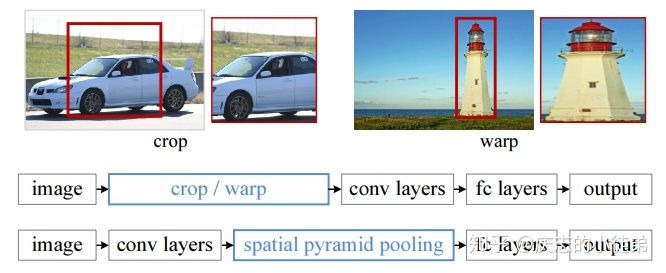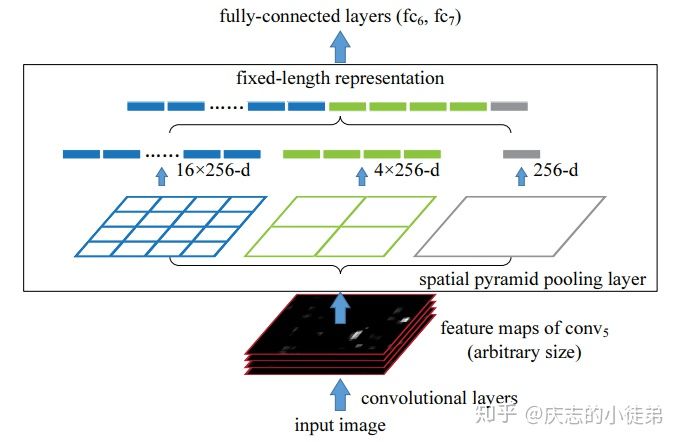一、 前言
在目标检测系列文章的上一篇R-CNN中,我们知道R-CNN在当时虽然取得了不错的成绩,但是其需要改进的地方也很多,比如算法步骤比较繁琐,需要大量的时间和内存去训练和测试模型等。除此之外,在训练和测试常见的CNN网络时,要求输入的图像有一个固定的大小,比如要求图像的输入为224*224。(网络前面的卷积层不要求输入图像的大小,后面的全连接层的输入特征数是固定的,需要固定的输入)这就要求我们在使用网络前需要对图像进行一些预处理操作,比如:裁剪(crop)、拉伸(warp)等。文章《Spatial Pyramid Pooling in Deep Convolutional Networks for Visual Recognition》提出来一种Spatial Pyramid Pooling(SPP)结构来解决这种问题,将这种结构放在卷积层与全连接层中间,在多个测试中取得了不错的效果。

上面需要加入一些裁剪等操作,才能得到一个固定大小的输入,下面只需要加一个SPP层就可以达到相同作用,并且还有其他优点。
二、SPP原理
SPP的原理论文里写的很简单,在这里要重新回顾一下CNN中的一些问题:
- 当尺寸大小不同的图像输入到相同的多层卷积网络中,得到的feature map大小是不同的,数量是相同(相同的filters)。
- 对一个一个固定的CNN,全连接层的输入是一个固定的数值(这个数值提前设置好的),这就需要使用SPP插入多层卷积和全连接层中间。
在上面两个问题的基础上,以下图为例介绍核心的思想。

SPP原理图
- SPP的核心在于使用多个不同尺寸sliding window pooling(上图中的蓝色4*4、青色2*2、灰色1*1窗口)对上层(卷积层)获得的feature maps 进行采样(池化,文中使用最大池化),将分别得到的结果进行合并就会得到固定长度的输出。
- 上图可以看出SPP层就是在前一卷积层得到的feature maps上进行了3个池化操作(实际情况根据自己设定的池化个数,控制全连接层的输入,下面会讲)。最右边的就是原图像,中间的是把图像分成大小是4的特征图,最右边的就是把图像分成大小是16的特征图。这样每一个feature map就会变成固定的21(16+4+1)个feature maps。
通俗的讲,SPP就相当于标准通道层,不管任何大小的图像,我都用一套标准的pool(文中说叫: l-level pyramid)对图像进行池化,最后组合成一列相同大小的特征,作为全连接层的输入,这一组相同大小的特征是固定的,可以提前进行计算,计算的方法和规则下面进行讲解。
三、Single-size training 计算规则
为了便于理解,我们将原文中一大段话整理为下面几个步骤,并在最后给出一个论文中的图,辅助理解。
- 按照传统CNN网络,对于图像的输入需要一个固定的大小,假设为224×224。
- 经过五个卷积层后,conv5输出的 feature maps的大小为a×a。在第一步假设输入大小为224×224的基础上,feature maps的大小为13×13。
- 开始使用SPP层插入在conv5层后(对应SPP原理图),SPP层中想要得到一组n×n的和的特征(比如SPP原理图中1×1、2×2、4×4........一旦确定,就固定了),文中举例用的n=3、2、1。想要得到这样的一组特征,就要使用一组sliding window 对conv5层得到的feature maps进行pooling。这里涉及sliding window的大小(win)和步长(str)计算,计算如下:

n=2,n=1以此类推(那两个计算符号分别为:向上取整和向下取整),将3个pooling后的结果合并,可以得到如下图。

上图是一个3-level pyramid pooling,sizeX是sliding window的大小,stride是步长。
四、SPP评价
考虑到SPP就是为了奔着打破一些传统网络和形式的目的搞出来的,所以优点主要有:
- 解决输入图片大小不一造成的缺陷。
- 由于把一个feature map从不同的尺寸进行pooling特征抽取,再聚合,提高了算法的robust和精度。
- 图像分类、目标检测都可以用,而且效果很棒。
- 一定程度上缓解了R-CNN耗时过多等问题。
最后,放一张论文中的图,用不同尺寸的sliding window去pooling一张图(feature map)确实可以获得更多的特征。

参考文献
[1] Spatial Pyramid Pooling in Deep Convolutional Networks for Visual Recognition
转自:https://zhuanlan.zhihu.com/p/39717526
其它文章:https://blog.youkuaiyun.com/hjimce/article/details/50187655























 1353
1353

 被折叠的 条评论
为什么被折叠?
被折叠的 条评论
为什么被折叠?








